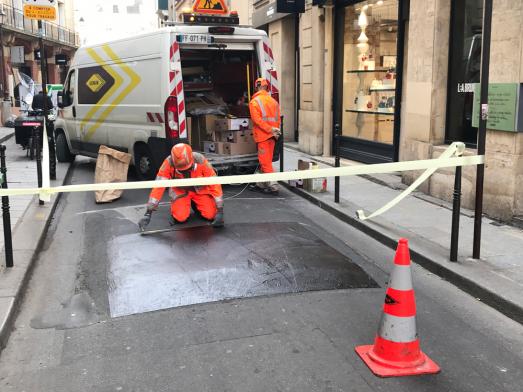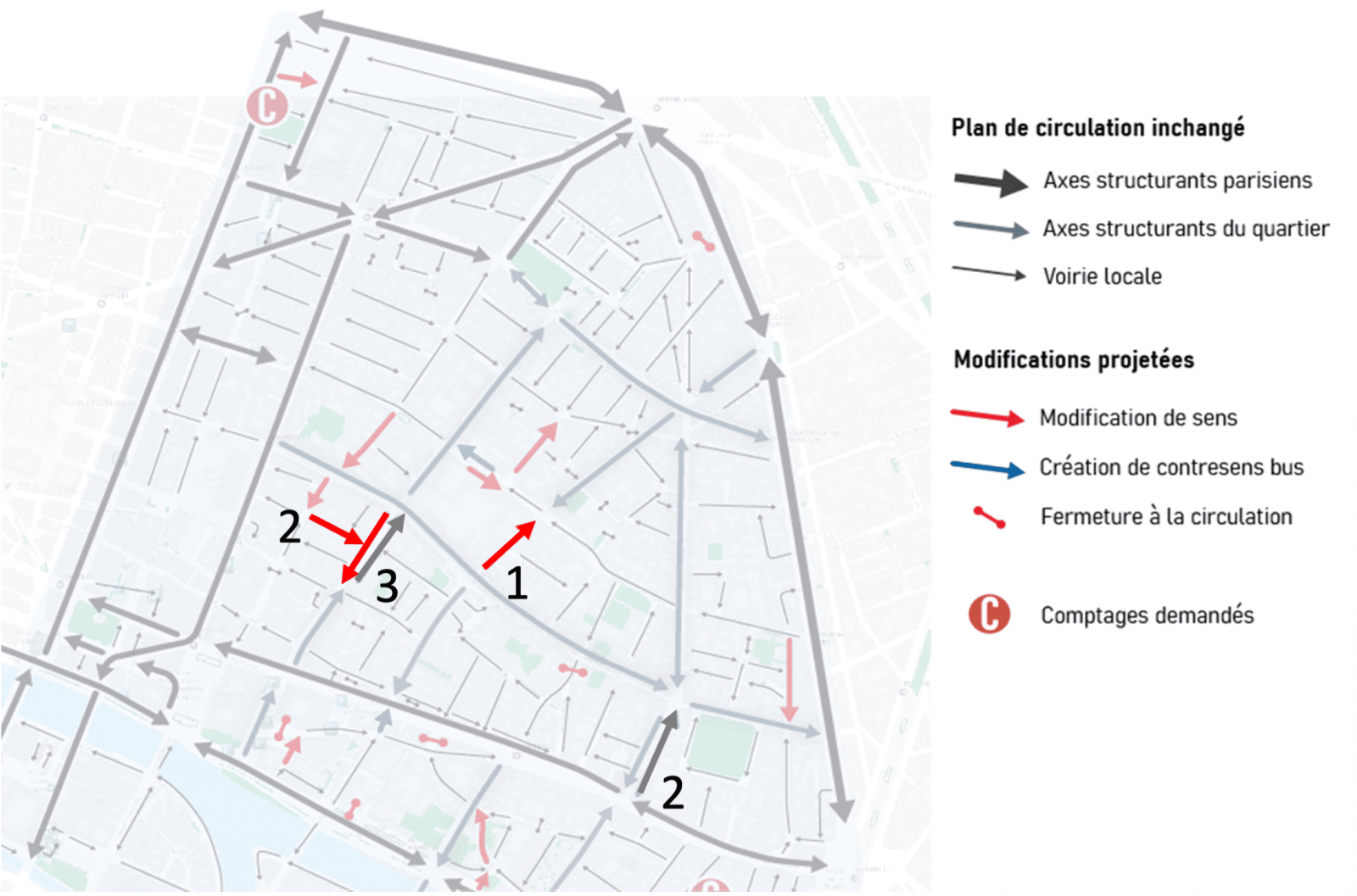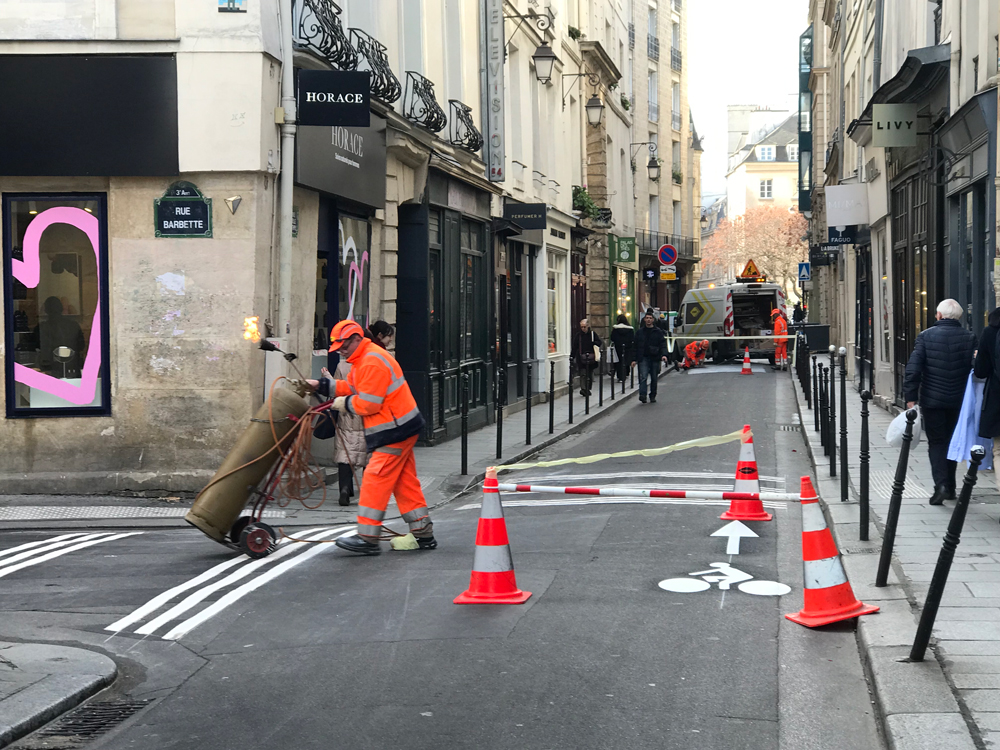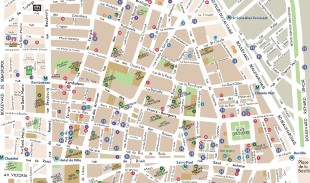Traffic plan for the Marais. What do the residents think?

New traffic plan for the Marais. What do marsh dwellers... and visitors think? To tell the truth, we don't know what to think. A priori benevolent on everything that can improve the quality of life, the risks of accident and pollution, we welcome it as a step forward because it will prevent trucks in transit from taking shortcuts in the small streets of the Marais, especially the rue Charlot and the rue Vieille du Temple from the Boulevard du Temple... Good intentions, consultations conducted with residents, but yet very unenthusiastic local residents and merchants.
On the tourism side, there is a definite lack of understanding of the needs of hoteliers, VTCs and other tourist actors in the most touristic district of Paris. It was an opportunity to create cab drop-off points in front of the numerous hotels... But no, not thought! Finally, the biggest disappointment is to see no real pedestrian street created for the benefit of pedestrians as it has been done everywhere in Europe for 40 years. The lower part of the rue du Temple, very well laid out, multiplied by 100 would have been - from our point of view - a real advance. This unambitious plan will probably generate a lot of wasted time for local residents, deliverymen, VTC and consequently generate more pollution and no less stress. And that's without counting on the strength of habit of the inhabitants who will turn longer in the new labyrinth before joining their underground parking, some of them like the one of the huge residence of the 70's at 6 rue des Haudriettes has more than 500 places on 8 floors in the basement!
Residents with the "vignette" and "carte Résident Paris Centre" who have a car and only use it to leave Paris or during off-peak hours are furious that they will not be able to use the new lanes that will be authorized only for buses and cabs, even though they have the right to use the rue de Rivoli with this same card. Paradoxical and incomprehensible... The very influential association Vivre le Marais has launched a petition in this sense which has already collected more than 1100 signatures. A certain number of other associations are ready to go to court to have this traffic plan cancelled...
The work will take place in several phases from February to September. "For three years that we have been living in a permanent construction site, we will hardly see it", says a shopkeeper of the rue de Poitou... Let's meet in September to see for ourselves if the life of the inhabitants has been optimized and secured... Let's be optimistic. We retain and we will proclaim it loud and clear "Stop bringing your car in Le Marais" International visitors are asked to come to the Marais by train and not by car. That's a very good thing. We'll have to let Fashion Weeks clients from Belgium, Switzerland, Germany, the Netherlands and Italy know, with their 4 x 4s with non-local license plates, that they're not allowed to clutter up the area around the Carreau du Temple - leaving their diesel engines running - which they wouldn't do without a heavy fine in other cities. The Municipal Police would have an interesting mission to play, wouldn't they?
Survey and photos Pascal Fonquernie
The New Marais Traffic Plan:

Excerpts from the press kit of the City Hall of Central Paris concerning this new traffic plan.
The starting point
The Mairie de Paris Centre is reworking the traffic plan for the 3rd and 4th arrondissements, in consultation with residents and local stakeholders in 2021-2022, with implementation beginning in early 2023 and lasting until the summer. The districts of the Marais: Enfants Rouges, Arts et Métiers, Arsenal, Îles Saint Louis and de la Cité are appreciated by their inhabitants and visitors for their cultural richness as well as for the hyper-proximity of services necessary for daily life, linked to their particular configuration characterized by narrow streets generating a very high pedestrian density. However, their central geographical location makes them a "shortcut" route for through traffic, which only passes through, causing congestion and nuisances for the inhabitants: noise, road insecurity, air pollution and deterioration of traffic conditions for buses and local users who need to travel by vehicle.
The facts
While 70% of the households in the district do not own a car and only 8% of the residents' home-to-work trips are made by vehicle, often for intramural trips, these nuisances have become unacceptable for many citizens, first and foremost for the families who are confronted with them on their way to school, and they are calling on us to find a solution. Improvements have been made and others are planned to make the area around schools safer, widen sidewalks and create pedestrian plazas. They are necessary but cannot, on their own, eliminate the excess of pure transit vehicles in the neighborhood. It will continue to pour opportunely into our small residential and commercial streets as long as the traffic plan makes these routes possible, and even recommended by GPS.
At the level of the entire Paris Centre (arrondissements 1, 2, 3 and 4), a response will be provided by 2024: the implementation of a limited traffic zone (ZTL) in which through traffic will be prohibited for the benefit of residents and local services. This measure will significantly reduce traffic, congestion and associated nuisances on all streets, and in particular on the main roads that are most affected by them today. To guarantee the success of this measure and to ensure that it also benefits the smaller streets within our neighborhoods, the Mayor of Central Paris and the City of Paris committed themselves during the municipal elections to redesigning the traffic plan of Central Paris in a progressive and anticipated manner.
Within the context of a major consultation process, the choice of changes to be made to the direction of traffic on the streets has been greatly influenced by the observations and proposals of residents, users, shopkeepers, local and institutional players (parking concessionaires, RATP) during various public meetings and workshops in 2021-2022, the materials and reports of which are available on the website of the Paris Centre City Hall... All of the major arteries will retain their current direction and will continue to be used to carry most of the traffic linking the various districts of Paris Centre. They constitute a legible framework for travel on the scale of our 4 districts. To ensure the safety of all users, bicycle facilities exist or are planned as part of the bicycle plan on these major roads: Bd de Sébastopol, Bd Henri IV and Pont de Sully, Grands Boulevards, rue de Turbigo, rue Réaumur, rue Beaubourg and rue Renard, Bd du Palais, Quais hauts, etc. Local structuring axes are defined and constitute a privileged network for users' journeys within the 3rd and 4th districts: rue de Bretagne, rue de Turenne, rue des Francs Bourgeois, rue Saint-Paul, rue des Deux Ponts, etc. Within this network, all the other streets, which are often narrow and whose lanes must be kept clear to ensure the quality of the public transport service, are intended to accommodate flows that are reduced to destination traffic only: residents of the surrounding area and their visitors, deliveries from shops, craftsmen, cabs, etc. Some of these streets are subject to changes in their traffic direction in order to achieve the dual objective of pacification and maintaining accessibility from the main roads.
What are the objectives?
The traffic plan chosen aims, above all, to improve the comfort of pedestrians, who are the priority users of the public policies of the Mairie Paris Centre and the City of Paris. Pedestrians, especially the most vulnerable among them, starting with children and their families, seniors and people with reduced mobility, for whom the metro is rarely accessible, are also often users of public transportation. Thus, in each development project carried out by the City Council, the safety and comfort of pedestrians and the fluidity of bus traffic are favored above all. The proposed traffic plan therefore includes compliance with the rules of co-visibility to ensure better safety for pedestrian crossings and the creation of new "meeting zones" where pedestrians have priority on the road when sidewalks are too narrow.
This traffic plan also reflects the unprecedented priority given to public transport in this district, with the creation of new bus lanes on rue des Archives, rue des Quatre Fils and rue de Turenne, which will significantly reduce travel times, particularly for lines 29 and 75 to cross the Marais. It will also make it possible, in the streets affected by changes in the direction of traffic, to improve conditions for firefighters by adopting roadway design standards that facilitate the deployment of ladders from their trucks, and to increase the number of parking spaces dedicated to deliveries, to people with reduced mobility, and to bicycles.
With the exception of a few very short portions of street that are entirely pedestrianized (for example, part of the Rue de l'Hôtel de Ville), all addresses that are currently accessible by car will remain so with this new traffic plan.
Read all the details on the website of the City of Paris Centre: https://mairiepariscentre.paris.fr/pages/revision-du-plan-de-circulation-du-marais-et-de-iles-dans-le-cadre-de-la-demarche-embellir-19565





.jpg)

